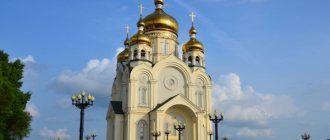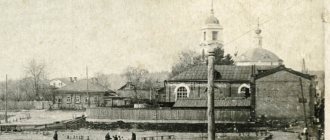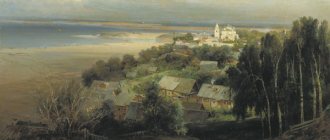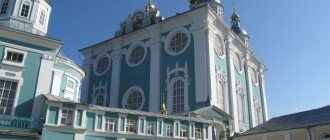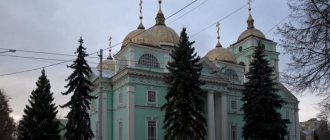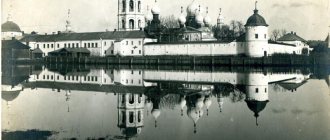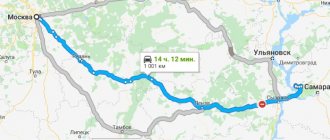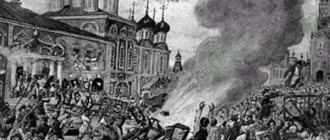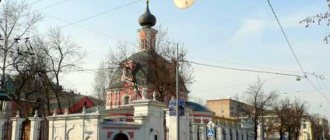The Ascension Cathedral is considered the most important temple in Novosibirsk.
In its altar you can see the ark with the relics of seventy shrines. Among them are the stone of Mount Sinai, a leaf of the Burning Bush of Sinai, a particle of the Holy Sepulcher, holy myrrh, part of the Mamre oak, etc.
© Anna Kudryavtseva
The Orthodox shrine is already more than a hundred years old. It was erected by the construction committee on the initiative of the diocesan authorities in 1913. True, the building only vaguely resembled a modern cathedral. After all, initially the temple was single-altar (Christians call the throne in the middle of the altar), wooden and with one bell tower. The newly built church was consecrated in April 1913 by Archpriest Nikolai Zavadovsky.
At that time, only one priest and a psalm-reader served in the church. Eleven years later, a bishop's chair appeared in the church. At the same time, in 1924, thanks to Metropolitan Nikifor, a chapel was added to the temple (by chapel, Christians mean part of the main church building or an additional extension), which bears the name of St. Nicholas the Wonderworker. Twelve years later, the Ascension Cathedral temporarily becomes a granary. Such changes are associated with mass persecution (the arrest of Archbishop Sergius and a group of clergy). But already in 1944 the cathedral again opened its doors to parishioners.
In 1946, six bells were installed on the church belfry.
The weight of the largest bell of the Ascension Cathedral is 340 kg.
© Anna Kudryavtseva
The year 1947 is an important and significant period in the history of the cathedral. It was then that the temple acquired another chapel (this time in the name of St. Seraphim of Sarov) and received the status of a cathedral.
There were different periods in the history of the temple: complete decay in the 70s, and subsequent reconstruction in 1974, which was completely completed only in 1988. After it, the building had stone walls decorated with paintings, as well as a mosaic above the entrance. The lower temple was built. Two years later, a chapel and an administrative building were erected next to the cathedral. For the seventy-fifth anniversary of the Novosibirsk diocese, the main iconostasis of the temple was also updated.
Ascension Cathedral in Novosibirsk (official website)
The lower church of the Ascension Cathedral is also worth mentioning. Built in honor of Alexander Nevsky and forefather Gideon in 1979, it attracts pilgrims with the “Life-Giving Spring” icon of the Mother of God.
Diocesan administration building, © Anna Kudryavtseva
History of the temple
The history of the temple dates back to the moment when, instead of a stone prayer house, a wooden single-altar Church of the Ascension was built in conjunction with a single-tier bell tower. Construction was carried out under the direction of city architect Fyodor Ramman on the poor urban outskirts of Novonikolaevsk in 1912.
The construction of the church proceeded without a clearly approved project using funds from a special fund and voluntary donations from the population, in particular Lieutenant General Vykulovsky-Donzinsky, who donated funds in the amount of 3 thousand rubles to the temple. A little more than 9.5 thousand rubles were spent on the entire construction, excluding donated building materials.
After the consecration, the temple was assigned a staff of 1 priest and 1 psalm-reader.
After the creation of the Novonikolaevsk diocese, the church became a cathedral, a new chapel was built, consecrated in the name of St. Nicholas the Wonderworker. After the arrest and execution of Archbishop Sergius and Archpriest Vasily Kurkov, the church was closed in 1938 and used as a warehouse and granary.
But already in April 44, regular services were resumed in the temple, so the church was perfectly preserved, it was enough to clean and restore order inside. It was striking in the surprisingly good condition of the iconostasis and all the thrones; even most of the ancient candlesticks were preserved.
And in 46, the church domes were again raised onto the belfry, and construction of a new chapel began in honor of Seraphim of Sarov. During the war, with the blessing of the archbishop, Orthodox residents and parishioners of the church organized regular collections of funds for the front and the preparation of gifts for the military.
Feeding military units and interaction with law enforcement agencies continues in the temple to this day. Since 1947, the Church of the Ascension has been given the status of a cathedral.
In the 70s of the last century, the original appearance of the wooden temple underwent a serious reconstruction:
- reconstruction of the western part of the temple;
- increasing the vestibule;
- replacement of internal columns;
- the gradual construction of stone walls to replace wooden ones;
- arrangement of the lower temple with the Alexander Nevsky limit and the throne of the forefather Gideon.
Later, a lot of work was done to improve the area adjacent to the temple. Now there is a very cozy courtyard. The temple stands picturesquely surrounded by tall trees. The bishop's choir accompanies all main and festive services in the church, conducts concert performances at diocesan events and festivals of spiritual revival in the city.
The collective has been continuously conducting professional choral activities since 1946 and already has its own certain foundations and established traditions, which are carefully preserved by all the choir directors. The permanent core group consists of 20 people; soloists of opera houses, philharmonic artists, and many conservatory students sing.
There is also a children's choir at the church, which began its work as the first and only one in the diocese in 1993. It consists of 2 age groups, the older of which regularly takes part in church services, and the younger group sings in church only a few times a year.
The children's group actively participates in city holidays, in diocesan Christmas concerts, and sings at children's liturgies in other churches. Children from all over the city participate in the children's choral group. The church choir has already celebrated its centennial anniversary.
His team takes part in everyday daily services, which take place twice a day, and sing at prayer services, weddings, and memorial services. Obedience is difficult, and the workload is quite high, since professional musicians spend almost entire days in the temple from early morning until late. But despite this, many singers have been serving for decades.
Ascension Cathedral
Ascension Cathedral is the main temple of our city of Novosibirsk. It houses the department of the Bishop who administers the Novosibirsk Diocese.
Initially, the Church of the Ascension was single-altar, wooden, with a bell tower in one frame, covered with iron. The church was built with the permission of the diocesan authorities and the diligence of the construction committee. On April 6, 1913, the dean of the Novy Nikolaev churches, Archpriest Nikolai Zavadovsky, consecrated the newly built church.
Located on the northern outskirts of the city, the temple was then one of the poorest in Novonikolaevsk. According to the decree of the Holy Synod, the staff of the Church of the Ascension consisted of one priest and one psalm-reader.
The first rector of the temple was priest Gabriel Lebedev.
Lebedev Gavriil Nikanorovich was born in 1886. In 1909 he graduated from the Tomsk Theological Seminary with a second class degree and was ordained a priest. On April 30, 1910, at his request, it was moved to the Church of St. mchch. Flora and Lavra Art. Zeledtsevskaya II deanery. Three years later, on April 1, 1913, he was transferred to the Ascension Church in Novonikolaevsk, and in 1915 a new decree followed - assigning him to the church in the village of Nizhne-Chemsky.
Father Gabriel's successor as abbot was priest Vasily Kurkov.
Kurkov Vasily Andreevich was born in 1882; He graduated from the Biysk Missionary Catechist School and the regency classes of the St. Petersburg Court Chapel. For four years, from 1902 to 1906, Vasily Kurkov taught in church schools. On July 27, 1906, he was ordained a deacon at the Church of the Mother of God of Kazan in the village of Deminskoye, and three years later, in 1909, a priest. In 1910, at his own request, he was transferred to the second priestly position at the Holy Trinity Cathedral in the city of Kolyvan, and in 1912 he was appointed county anti-sectarian missionary of the Tomsk diocese. In 1915, by decree of His Eminence Anatoly, Bishop of Tomsk, Father Vasily Kurkov was transferred to the Ascension Church in Novonikolaevsk.
The report of the second rector of the temple, priest Vasily Kurkov, dated March 16, 1915, points out the remote location of the temple (“on the outskirts of the city”) and the extremely poor situation of the parishioners. According to Father Vasily, the houses of the parishioners for the most part consisted of “hastily put together small shacks, which speak quite clearly about the financial situation of their inhabitants.” (GANO. F. D-159. Op. 1. D. 89. L. 4.4 vol.) The population of the parish was the most diverse, as they say, “from the Kama, from the Volga”: here are Tatars, Zyryans, and those who speak poorly in Russian, “there are many people of other faiths and heterodoxes, and most importantly, what is saddest of all, sectarianism is widely developed. The majority of the parishioners are unskilled workers, small artisans, getting by somehow, living solely on their daily earnings. People are not financially secure at all. The daily pursuit of a piece of daily bread, a low level of mental development, the lack of the necessary cohesion and solidarity in general parish life and spiritual needs of the highest order, as well as religious vacillation due to the propaganda of sectarianism - all this taken together directs the religious life of the parish on the wrong path, making very the general attempt of the clergy to create something in this new and completely unsettled parish was difficult,” wrote priest Vasily.
At the parish of the Ascension Church there were three primary parish schools of the Ministry of Public Education.
Since 1924, when the Novonikolaevsk (and later Novosibirsk) diocese was formed by decree of the Holy Synod, a new period begins in the history of the Ascension Church. Through the efforts of the first bishop, Metropolitan Nikifor (Astashevsky; †1937), a chapel in the name of St. Nicholas and the Wonderworker was built at the Church of the Ascension in 1925.
Metropolitan Nikifor's successor, Archbishop Sergius (Vasilkov), did not serve long. In 1937, he, along with a group of laymen and priests, among whom was Archpriest Vasily Kurkov, was arrested and shot.
During the years of persecution of the Church, the Ascension Church was closed (1938 - 1939). The city authorities used the church as a grain warehouse.
In Novosibirsk, which had almost a million inhabitants, there was only one functioning small Assumption Church.
Since August 1943, the Novosibirsk diocese has been ruled by Archbishop (later Metropolitan) Bartholomew (Gorodtsev; †1956).
In April 1944, services resumed in the Church of the Ascension. Here is what Bishop Bartholomew writes about this in his diary: “In March, the Lord helped us get a second church for Novosibirsk: Ascension (Turukhanskaya); Believers began to worry about it a long time ago, for more than two years; but this year my secretary, Father Nikandr, went to Moscow, where he outlined the needs of Novosibirsk, which, with a population of almost a million, has only one small Assumption Church. At the end of the sixth week of Great Lent, a decision was received from the Council for the Affairs of the Russian Orthodox Church to give this temple to the believers. This temple is relatively large, and did not require urgent repairs - the iconostasis, thrones, candlesticks, etc. - everything turned out to be in order; therefore, after the church was washed and cleaned, on Holy Wednesday in the evening I performed a small consecration of the temple; and on Maundy Thursday the service began there - to the great joy of all the people; the church was overcrowded with people during all services, and on Easter night there was such a roar in the church from so many people that it was difficult to serve; and when we left the church with the procession, we saw that the entire vast fence was crowded with people, the night was warm, quiet, everyone’s candles were burning - a touching picture. Everyone rejoiced at both the Holy Resurrection of Christ and the newly opened church.”
Commissioner for the Affairs of the Russian Orthodox Church under the Novosibirsk Regional Executive Committee P.P. Sozonenok in his information reports on the state and activities of the Orthodox Church in the Novosibirsk region on December 15, 1946 and for the period from April 1 to July 1, 1946. “On Easter, during the consecration of Easter cakes, up to 5,000 people visit the Ascension Church, up to 2,500 people visit the Assumption Church, up to 4,000 people visit the Ascension Church on Trinity, up to 1,500 people visit the Assumption Church, on patronal feast days, about 3,000 people visit the Ascension Church, up to 1,000 people visit the Assumption Church.”
At the end of March 1946, bells were raised on the Church of the Ascension. This is what Comrade writes. P.P. Sozonenok about this event: “In March of this year. The church council of the Ascension Church purchased a church bell weighing 21 pounds from one of the factories of the plant No. 179. This bell and 6 small bells of 8 kilograms or less are raised to the church at the end of March and the bells are ringing.”
The archpastor used a lot of effort and resources to restore and improve the Church of the Ascension. In 1946, through his efforts, the construction of a new chapel began. And on December 28, 1947, Archbishop Bartholomew solemnly consecrated the new chapel in the name of St. Seraphim of Sarov.
Bishop Bartholomew loved the Church of the Ascension very much, and after his blessed death in 1956, he found his resting place here. The tomb of the elder who died in Bose is located in the Seraphim chapel.
The Church of the Ascension was elevated to the rank of cathedral in 1947, when the metropolitan department was already organized and two new chapels were built.
During the Great Patriotic War, the clergy of the Novosibirsk diocese and, in particular, the Ascension Cathedral did not remain indifferent to the grief that befell the entire Fatherland. On the initiative and with the blessing of Archbishop Bartholomew, a collection of donations was organized among clergy and laity. For the needs of the army and the front in the period from 1944 to 1945, 1,686 thousand rubles were received from the Ascension Cathedral. In 1947, medals “For valiant labor in the Great Patriotic War of 1941-1945.” The administrator of the Novosibirsk diocese, Archbishop Bartholomew and the dean of the churches of the city of Novosibirsk and the secretary of the Novosibirsk diocese, Archimandrite Nikandr (Volyanikov) were awarded. Among the clergy of the diocese there were many front-line soldiers.
Since 1956, relations between Church and state have become very complex. Intensified atheistic propaganda, the closure of many churches, the regulation of all actions of clergy and the suppression of any initiative characterize this difficult time. But the life of the cathedral continued. With the blessing of Metropolitan Nestor (Anisimov; †1962), a tombstone is erected over the grave of Bishop Bartholomew, and through the efforts of Archbishop Paul (Golyshev; †1979) a stone baptismal church is being built to replace the dilapidated wooden one. By the seventies, the wooden Ascension Cathedral had fallen into disrepair. On February 12, 1971, a circus was opened next to the cathedral, as a result of which the cathedral territory lost one of its two entrances, and the temple itself found itself in a lowland.
His Eminence Bishop Gideon (Dokukin; †2003), who arrived at the Novosibirsk see in 1971, immediately became concerned about the condition of the church building. In 1974, the western part of the building was reconstructed, the vestibule was enlarged, and the columns inside the cathedral were replaced. After construction, the new brick walls were hidden under wooden siding to maintain the overall appearance of the wooden temple. In 1976, the walls of all three altars were one by one dismantled and replaced with brick ones, and by 1979 the lower church was built in honor of the Holy Blessed Prince Alexander Nevsky and Gideon the Forefather. Further, with the blessing of Metropolitan Gideon, a complete reconstruction of the Ascension Cathedral was carried out. The work was supervised by the then rector of the church, Archpriest Dimitry Budko (Archbishop of Kemerovo and Novokuznetsk Sophrony). The reconstruction was timed to coincide with the celebration of the 1000th anniversary of the Baptism of Rus'. The temple reconstruction project was carried out by Novosibirsk architect V.P. Avksentkzh. By August 1988, construction work was completely completed. And although during the reconstruction of the cathedral, government authorities did not give permission to make it taller and more spacious, as the church leadership and builders wanted, it became a true decoration of Novosibirsk. In several stages, the modest wooden building was transformed into a spacious stone building, painted inside and beautifully decorated outside.
In 1989, at the VII All-Russian review of the best architectural works, the work of the Novosibirsk architects who created the new look of the Ascension Cathedral was awarded the highest award - a 1st degree diploma and a medal of the Union of Architects of Russia.
The architecture of the temple is harmonious, without frills. Now the cathedral has not five as before, but seven gilded domes. A cross is raised above the entrance on the western side. The spacious hipped bell tower is single-tiered, square in plan with wide openings in which small and medium-sized bells hang.
A large bell—annunciative—is placed in the center of the belfry. It is decorated with images of the Mother of God, St. Nicholas the Wonderworker, a number of six-winged Seraphim, stenciled floral patterns, and relief belts. Along the lower circumference it is surrounded by the text: “O earths, preach great joy” and “Praise, O heavens, the glory of God.” The bell was made at the Olovyashnikov factory in Yaroslavl.
Three canopies, one above the other, rising to the bell tower, create the impression of a protruding entrance.
In the cathedral fence there is a baptismal room with a temple in honor of the Epiphany (Baptism) of the Lord, where the Sacrament of Baptism is performed daily. According to the design of the architect B.A. Zakharov built a chapel in honor of All Saints who shone in the land of Siberia in 1996 and an administrative building in 1998.
In 1999, to celebrate the 75th anniversary of the Novosibirsk diocese, the main iconostasis of the temple was restored and re-gilded.
In May 1991, the Novosibirsk diocese was visited for the first time by His Holiness Patriarch of Moscow and All Rus' Alexy II. During his stay in Siberia, His Holiness the Patriarch performed a divine service in the Ascension Cathedral.
In May 2002, His Holiness Patriarch Alexy II came to Novosibirsk for the second time to take part in the celebrations on the occasion of the Days of Slavic Literature and Culture. For the first time, our city became the all-Russian center for this holiday.
On May 23, 2002, His Holiness the Patriarch served an all-night vigil at the Ascension Cathedral, at which the canonization of the Hieromartyrs Nicholas (Ermolov) and Innocent (Kikin), Siberian priests who suffered from the godless authorities during the time of persecution, took place. The icons of these holy martyrs are in the altar of the cathedral.
On May 24, 2002, His Holiness Patriarch Alexy II celebrated a festive Divine Liturgy in the cathedral in honor of Saints Equal-to-the-Apostles Cyril and Methodius, the creators of Slavic writing.
His Holiness handed over the altar cross to the Ascension Cathedral. The ruling bishop, Archbishop Tikhon of Novosibirsk and Berdsk, expressed words of gratitude and presented His Holiness the Patriarch with the gift of the Siberians - the icon of the Mother of God “The Sign”. After the Divine Liturgy, a procession of the Cross took place, led by His Holiness, from the Ascension Cathedral along Krasny Prospekt to the St. Nicholas Chapel and to the Cathedral of the Holy Blessed Prince Alexander Nevsky. About 12 thousand people took part in the religious procession.
On May 21, 2003, the abbot of the St. Daniel Monastery in Moscow, Archimandrite Alexy (Polikarpov), delivered to Novosibirsk a particle of the holy relics of the heavenly patron of our city, St. Nicholas, the Wonderworker. The next day, the Divine Liturgy was celebrated in the Ascension Cathedral by Archimandrite Alexy and Archbishop Tikhon of Novosibirsk and Berdsk. On May 25, 2003, the icon of St. Nicholas with a particle of relics was solemnly transferred in a religious procession from the Ascension Cathedral to the chapel of St. Nicholas on Krasny Prospekt.
When preparing the material, data from E. Shabunin’s book “Temples of Novosibirsk. Historical Guide" and articles "From Wood to Stone"
https://vksnsk.ru/article/20
Architect and exterior decoration of the cathedral
Reconstruction of the temple, superbly executed according to the design of the architect V.P. Avksentyuk, noted as the best work of Novosibirsk architects and awarded a high award - a 1st degree diploma, as well as a medal of the Russian Union of Architects.
The style of the cathedral can be defined as classical, with characteristic elements of folk architecture:
- gable roofs;
- scaly lining;
- ornamental design of doors;
- intricate gutters;
- round dormer windows;
- decoration of window openings in the form of kokoshniks.
The rebuilt temple today is crowned with 7 gilded domes, and a cross also rises above the western entrance. The cathedral has a small height, but it looks majestic and proportional, and in conjunction with the hipped single-tier bell tower it makes a very harmonious impression.
After restoration, all the walls were carefully plastered and painted, and a mosaic panel with the image of the Virgin Mary was installed at the entrance. The walls of the temple facades are also decorated with mosaics.
Architectural ensemble of the cathedral
The Ascension Cathedral in Novosibirsk is distinguished by its modest and harmonious architecture, which is completely devoid of any excesses. In plan, the belfry building is a square with wide openings for bells. The main bell, weighing almost 350 kg, is located in the central part of the bell platform, surrounded by a set of other bells.
The Epiphany Church with a separate baptismal room was built in 1971.
In 1996, architect B.A. Zakharov erected a chapel in memory of the Saints of the Siberian land. The administrative building, built by the same architect at the end of the last century, organically fit into the architectural complex ensemble of the cathedral. There is also a parish school building and a church store, all buildings are made and decorated in the same style, each building has a separate entrance.
Shrines and relics of the temple
In the temple there is a piece of the Life-Giving Cross and the Sepulcher of the Lord and the Virgin Mary, a piece of the stone of Holy Golgotha, more than a hundred revered Orthodox shrines and miraculous icons with particles of the relics of great Saints.
Scroll:
- St. Nicholas the World of Lycian Wonderworker;
- Seraphim of Sarov;
- Healer Panteliimon;
- Saint Innocent;
- Joseph of Belgorod;
- Ambrose of Optina;
- John of Shanghai;
- Great Martyr George the Victorious;
- new martyrs.
Of the especially revered icons, we can highlight the temple image of the Ascension of the Lord, the Mother of God of the Life-Giving Spring, the Iveron Icon and the Quick to Hear from Holy Mount Athos.
Mentors
History of the mentors and abbots of the temple:
- The first rector of the Ascension Church was priest Gabriel Nikanorovich Lebedev, who served here from 1913 to 1915.
- The priest Vasily Andreevich Kurkov, appointed in his place, became his successor.
- In 1924, in connection with the formation of the Novonikolaevsk diocese, an episcopal see was formed here, headed by the 1st bishop, Metropolitan Nikifor Astashevsky.
- In 1937, Archbishop Sergius Vasilkov became his successor, who was shot that same year along with the laity and Archpriest Vasily Kurkov.
- In 1943-56, the administration of the diocese belonged to Metropolitan Bartholomew Gorodtsev, who found his rest here. A tombstone has been placed over his grave.
- Metropolitan Nestor Anismov headed the diocesan see in the period 1956-58.
- Donat Shchegolev became the next archbishop until 1961.
- Bishop Leonty Bondar headed the department during 1961-63.
- Archbishop Cassian of Yaroslavl led the diocese from 1963 to 64.
- The next bishop until 1972 was Pavel Golyshev.
- The most sacred Bishop Gideon Dokukin, who headed the department from 1972 to 1993, carried out a global reconstruction of the temple.
- Metropolitan Tikhon Emelyanov had to lead the diocese twice: in the period 1990-95 and 2000-18.
- Bishop Sergius Sokolov ruled the diocese from 1995 to 2000.
- The current Metropolitan Nikodim Chibisov has been ruling the Novosibirsk and Berd diocese since 2021.
Trinity-Vladimir Cathedral (Novosibirsk)[edit]
Trinity Cathedral
Trinity Cathedral (upper church of the Trinity-Vladimir Cathedral in Novosibirsk) is the cathedral of the Novosibirsk and Berd diocese of the Russian Orthodox Church, located in the city of Novosibirsk. It is a courtyard of the Archangel Michael Monastery in the village of Kozikha (Novosibirsk region).
Construction began in 1999. The temple can accommodate 1,500 people, has two levels (the upper temple in the name of the Holy Trinity and the lower one in the name of Equal-to-the-Apostles Prince Vladimir). The height of the temple is 60 meters (to the top point of the cross). The temple is cross-domed, six-pillared, three-domed with six thrones.
On August 24, 2013, Patriarch Kirill of Moscow and All Rus' consecrated the Trinity Cathedral.
Address
: st. Filatova, 14A, Novosibirsk, Novosibirsk region, Russia
Telephone
: +7 383 341-23-32
Service schedule, operating hours
The Ascension Cathedral in Novosibirsk is open every day.
Divine services are held daily according to the following schedule:
| Service name | Weekdays of the week | Sundays and holidays |
| Divine Liturgy | 9-00 | 7 and 10 o'clock |
| Sacrament of Confession | 8-30 | 6-30 and 9-30 hours. |
| Evening service | 17-00 | 17-00 |
| Sacraments of baptism | From Wednesday to Saturday from 12 to 16 hours. | from 10 a.m. to 4 p.m. |
| Wedding, except days of church fasts | Mondays, Wednesdays and Fridays at 13:00 and 16:00 | 13-00 and 16-00 hours. |
On Sundays and Thursdays after the evening service, akathists are chanted.
Temple of the Icon of the Mother of God “Quiet My Sorrows” (Novosibirsk)[edit]
On February 6, 1998, the first service was held. The new rector performed the rite of minor consecration of the Throne, and the next day, February 7, the first patronal feast was celebrated. Two weeks before the Holy Resurrection of Christ, an iconostasis was installed, which was made in a vocational school at a furniture factory, and the saints icons brought from St. Daniel's Monastery were purchased from the Diocesan Administration.
On May 17, 1998, Bishop Sergius visited the parish and donated to the parish the icon of the Most Holy Theotokos “Quench My Sorrows,” which was painted by his mother N.N. Sokolova.
Address:
Russia, Novosibirsk, Svyazistov street, 139/1
Phones:
+7 (383) 356-10-57, +7 (960) 791-84-12
Rules for visiting the temple
A visit to an Orthodox cathedral implies respect for the feelings of believers and visitors to the temple:
- Before entering the church, you should turn off the sound notification of your mobile device.
When entering the Ascension Cathedral, Novosibirsk, it is important to turn off your phone or switch it to silent mode. - When entering the building of an Orthodox church, it is customary for the male part of the population to bare their heads, and for women, on the contrary, to cover their hair with a scarf.
- Clothing must be appropriate to the gender of the visitor, decent and modest. It is not allowed to enter in shorts and T-shirts, a strong neckline or a mini skirt. You cannot enter the church barefoot.
- It is not customary to have loud conversations on the temple grounds, to disturb, to push, or to take photographs of worshipers.
- Silence and cleanliness must be maintained.
- Children should not be left unattended, nor should they be allowed to run, scream or play around in the temple. If a baby cries during a service, it is advisable to take him out and calm him down outside the church.
- It is prohibited to enter the temple premises with pets.
- It is not customary to bring food and ice cream to church, drink juices or chew gum.
- You should not enter the temple with large bags.
- It is prohibited to attend church under the influence of alcohol or drugs.
Patronal holidays
In Novosibirsk, the main cathedral church is the Ascension Cathedral, which solemnly celebrates its main holiday with a bishop's service every year on a different day, on the 40th day after Easter.
The patronal feast of St. Nicholas the Wonderworker is celebrated 2 times a year:
- Summer Nikola is celebrated on May 22;
- Winter is celebrated on December 19th.
On the days of memory of St. Seraphim of Sarov, a festive throne service is also held:
- January 15;
- August 1.
The patronal holiday in the lower limit is celebrated on December 6, the day of memory of the blessed Prince Alexander Nevsky. The Epiphany Cathedral celebrates its main temple holiday on the day of the Epiphany on January 19.
Content
- 1 Ascension Cathedral (Novosibirsk)
- 2 Alexander Nevsky Cathedral (Novosibirsk)
- 3 Trinity-Vladimir Cathedral (Novosibirsk)
- 4 Church of the Sign (Novosibirsk)
- 5 Church of the Intercession (Novosibirsk)
- 6 Assumption Church (Novosibirsk)
- 7 Temple of the Icon of the Mother of God “Quiet My Sorrows” (Novosibirsk)
- 8 Church of St. Nicholas (Novosibirsk)
- 9 Temple of the Venerable and Blessed Prince Oleg of Bryansk (Novosibirsk)
- 10 Church of the Annunciation of the Blessed Virgin Mary (Novosibirsk)
- 11 Temple of John of Kronstadt (Novosibirsk)
Interesting facts about the cathedral
His Holiness the Moscow Patriarch served in the church several times. The first divine service by the patriarchal rank was performed in May 1991, and in 2002, His Holiness, after the Divine Liturgy, presented the altar cross to the cathedral. In May 2003, the abbot of the Moscow Danilov Monastery, Archimandrite Alexy Polikarpov, delivered a particle of the relics of St. Nicholas to the temple.
The temple is very interesting and beautifully illuminated, so it is worth visiting it in the evening. The cathedral practically did not interrupt church life. Divine services were held in the temple even during the period of global restoration with the replacement of walls.
Concert poster for 2019
The organ sounds within the walls of the cathedral during vocal and instrumental performances, Sunday services and religious holidays. The concert schedule for 2021 is extremely rich and varied.
You can see such famous productions as:
- "Seasons".
- "A Little Night Serenade"
- "Toccata".
- "Moonlight Sonata".
- "Scottish bagpipes and organ."
- "Requiem" and many others.
In addition, several traditional international festivals are regularly held here, including the Bach Festival, Night in the Cathedral and Road to Christmas.
Information for visitors
The Ascension Cathedral in Novosibirsk is open to everyone every day, completely free of charge. On weekdays, the cathedral opens at 7-30 am, on Sundays and holidays at 5-30 am. The temple closes with the departure of the last visitor after the end of the evening service.
Every day from 12 to 17 o'clock a clergyman is on duty in the temple, who can advise and answer all the parishioners' questions.
There is a charity center at the cathedral, which provides all possible assistance to all those in need, and collects funds and material donations from citizens. The parishioners themselves actively participate in charitable activities.
Also, the center’s staff regularly visit patients in the psychoneurological department and orphans of the orphanage, conduct catechetical conversations and communicate on pressing issues in an individual form. Interesting congratulations and small gifts are prepared for the holidays.
The church organizes social work with teenagers at the drug treatment clinic, where general and individual educational conversations, holiday concerts, and joint events are also held. The Mercy Center provides regular assistance to lonely and seriously ill parishioners of the temple.
In the youth club, which has existed at the church for the second decade, young activists of the parish, under the leadership of the priest, conduct various events of a spiritual and social orientation. Meetings are held every week on Sundays at the parish school.
The children take part in round tables and discussion meetings on issues that are relevant to them, prepare lectures, invite specialists and interesting people for informal communication, and organize musical meetings and concerts.
Club members organize joint viewings of feature films and reading books, followed by discussion, studying Christian literature with interpretations of the Holy Fathers. The youth club also hosts interesting pilgrimage and labor trips.
The club's work also goes in the sports direction. Mini-football tournaments are held, the organization and conduct of which is entirely the responsibility of the youth. The church runs a Sunday school for children and adults.
Children are accepted to different levels of education:
- Preschoolers aged 3 to 7 years.
- The primary level consists of 4 classes for children from 8 to 14 years old.
Classes are held throughout the school year on Sundays and include the study of sacred history and Orthodox services, temple history and the church calendar, the lives of the Saints, iconography and the basics of church reading. The school hosts colorful matinees and concerts, trips to holy places and trips to museums.
In addition, classes are held in the theater studio, artistic embroidery, and photography.
In Sunday school classes, adults read the Holy Scripture with interpretation, learn to read in Church Slavonic, study church hymns and liturgics, get acquainted with church history and Orthodox holidays. Training is provided in the form of various conversations, film lectures, and practical seminars. The training is free for everyone.
The church has a rich Orthodox library with a collection of more than 30 thousand volumes of spiritual literature. In the church shop you can buy crosses and candles, various icons, Orthodox books and specialized literature.
Current state[edit]
Interior
On the territory of the Ascension Cathedral there is a temple-chapel in honor of the Cathedral of Siberian Saints; consecrated in 1997.
Activities of the parish[edit]
- Sunday School
At Sunday school, teachers teach children the basics of faith, sacred and church history, church singing, as well as crafts and drawing. In Sunday school they hold conversations with adult parishioners, study Sacred history, teach parishioners Church Slavonic reading, singing troparions, akathists, chanting the Divine Liturgy and other prayers.
- Social service
The parish of the Ascension Cathedral is actively involved in social service and charity. The head of the department for social service and charity at the parish is the commandant of the Ascension Cathedral Bryntseva Liliya Alekseevna. Mercy Center
The Orthodox Center of Mercy (OCM) works in two directions: missionary and catechetical activities, and also actively participates in charity.
- Youth meetings
Throughout the year, every Sunday youth meetings are held at the parish school of the Ascension Cathedral in Novosibirsk. The format of the meetings is different: lectures, a discussion club with a discussion of the topics most interesting for modern youth, conversations on the Gospel, viewing and discussion of films of a spiritual orientation, meetings with clergy and youth of other Parishes of the Novosibirsk Diocese, tea drinking.
- Working with law enforcement agencies
The clergy of the Cathedral constantly cooperate with the Ministry of Internal Affairs in matters of maintaining order and ensuring security during the organization and conduct of church holidays associated with large gatherings of people (Nativity of Christ, Epiphany, Easter, Memorial Day of Saints Cyril and Methodius). The priests of the Cathedral conduct the Sacrament of baptism for military personnel; talk with conscripts, bless them for military service.
How to get there
The temple can be easily reached by public transport:
- By metro to Sibirskaya or Krasny Prospekt stations.
- To the Circus stop on bus routes No. 3, 13, 14, 18, 28, 32, 34, 35, 64, 75, 79, 97, 98, 189.
- On trolleybuses No. 2, 5, 13, 23, 29, 36.
- By minibuses No. 2, 13, 44a, 45, 1016, 1048, 1057, 1118, 1128, 1234.
It is convenient to get to the cathedral by private car, as there is a large free parking lot next to the temple. The Cathedral in honor of the Ascension of the Lord is not only an architectural decoration, but the main spiritual center in Novosibirsk, a favorite and visited place not only by citizens, but also by guests of the city.
Church of the Annunciation of the Blessed Virgin Mary (Novosibirsk)[edit]
On April 13, 1995, we received a blessing from Bishop Tikhon, Bishop of Novosibirsk and Barnaul, to create a community in honor of the Annunciation of the Most Holy Theotokos. Father Sergius Fedoseev, the rector of the church in honor of the Nativity of the Blessed Virgin Mary, was appointed as the caretaker.
On May 3, 1995, with the participation of priests Sergei Fedoseev and Anatoly Noskov, the first meeting of the community was held at school No. 121. At the meeting, the head of the community, Alexander Georgievich Usov, an accountant, treasurer and an audit commission were elected.
Address:
Russia, Novosibirsk, st. Russian, 2
Telephone:
+7 (383) 330-29-97
